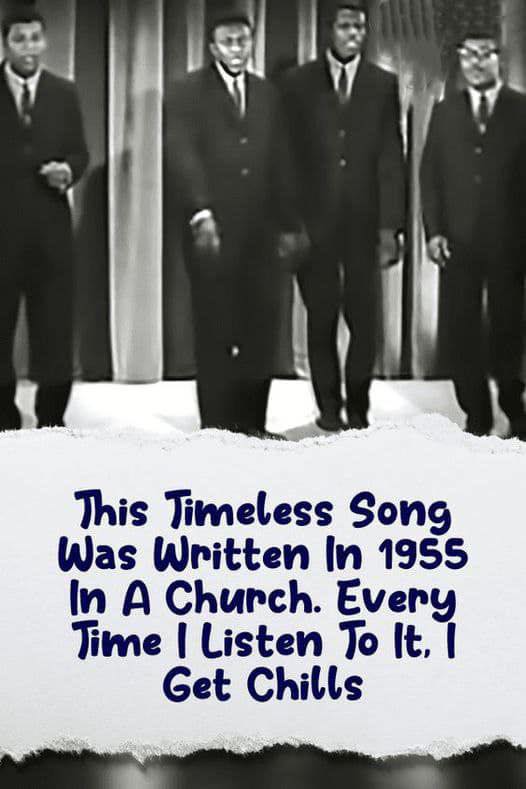The G-Clefs of Roxbury, Massachusetts, a vocal quintet, made New England famous in the pop music world in 1955 when their song “Ka Ding Dong,” recorded at Ace Recording Studios in Boston, peaked at #24 on the Billboard Hot 100 and #9 on the R&B chart.
They were the first group from the area to make those lists.
However, a different New England singing trio had a hit in 1956 that left an even more enduring impression. Although the group was actually a quintet performing in a church basement, the popular song “In the Still of the Nite” was recorded as a quartet by The Five Satins of New Haven, Connecticut.
While “Ka Ding Dong” fell into the abyss of obscurity years before The Beatles debuted on The Ed Sullivan Showin February 1964, by that time “In the Still of the Nite” was a bona fide pop classic. With estimated sales of over 50 million copies roughly half that as part of the soundtrack for the 1987 film Dirty Dancing—it’s safe to assume that “In the Still of the Nite” is the overwhelming reason why The Five Satins have been inducted into the Rhythm & Blues Foundation Hall of Fame (in 1998) and the Vocal Group Hall of Fame (in 2003) and The G-Clefs have not.

FORMATION, EARLY PERFORMANCES
Fred Parris, then 17 years old, along with five of his friends from Hillhouse High School—Stanley Dortche, Ed Martin, Jim Freeman, Nat Mosley, and Lewis Peeples—formed the group in 1954 as a sextet. Fred’s previous band, The Scarlets, had released the local hit song “Dear One” the same year. Dortche and Peeples quickly fled. When Al Denby joined, the quintet became immortalized in the world of doo-wop.
They were just one of the many groups that sang at the Dixwell Community House or on the corner of Dixwell Avenue and Webster Street in New Haven before hitting the Chitlin’ Circuit. This was long before they performed at venues like The Apollo in Harlem and shared bills with Little Richard, The Platters, and other acts.
“IN THE STILL OF THE NITE” INSPIRATION
Parris, who wrote “In the Still of the Nite” while in the Army, claimed that meeting “the girl of my dreams” at the Savin Rock Amusement Park in West Haven served as the inspiration for the song. He wrote the lyrics and the melody while riding the train back to his base in Philadelphia after seeing her. “When I got to the camp,. I went straight to the day room,” he said in an interview with Smithsonian magazine in 2004. “There was a piano there, and I started playing the chord in my head and the words in my heart.”
“BLESSED” BY CHURCH ACOUSTICS
The trio recorded the song on February 19, 1956, while Parris was on leave in New Haven. Parris revealed this to Bob Belniak, the editor of the New England Doo Wop Society’s magazine, Echoes of the Past. Parris, Freeman, Martin, and Denby joined by pianist Curlee Glover, bassist Doug Murray, drummer Bobby Mapp, saxophonist Vinny Mazzetta, and producer Marty Kugell operating a two-track machine in a temporary studio in the basement of St. Bernadette’s Catholic Church on Townsend Avenue.
Asked in a 2013 interview on the radio show Doo Wop Revivalwhy he thought the resulting acoustics were so perfect, Parris offered a spiritual explanation: “Because we did it at the church,” he said. “I think the song was blessed. And so was I.”
LOCAL HIT, NATIONAL HIT, #1 REQUESTED SONG
Parris used the spelling “Nite” to avoid confusion with Cole Porter’s “In the Still of the Night” (written in 1937), and the song, sometimes written as “(I Remember) the Still of the Nite” or “Night,” – was released in the spring of 1956 on producer Kugell’s label Standord Records, then by New York-based Ember Records after it became a local smash. Soon it was the #1 listener-requested song on pioneering deejay Alan Freed’s nightly show on WINS in New York, and Freed often playing it as the closing track.
BILLBOARD HOT 100 RECORD, AMERICAN BANDSTAND REGULARS
It peaked at #24 in the Billboard Hot 100 and #3 in the R&B chart in November 1956. The song was virtually always ranked #1 in the Top 500 Songs countdown of New York oldies station WCBS-FM for the following thirty years, during which time The Five Satins became a regular on American Bandstand. In 1960 and 1961, the song made the Hot 100 again #81 and #99, respectively and it’s one of only two non-Christmas tunes to have reached that chart on three separate occasions by the same artist doing the same version (the other being Bobby “Boris” Pickett and the Crypt-Kickers’ 1962 hit “Monster Mash”).
ORIGIN OF “DOO WOP,” DIRTY DANCING, COVER VERSIONS
Frequently recognized as the source of the term “doo wop” due to its “doo wop, doo wah” bridge, “In the Still of the Nite” debuted on the Dirty Dancing soundtrack in 1987, selling 32 million copies. Numerous artists have covered the song, including Paul Anka (1969), The Beach Boys (1976), Ronnie Milsap (1986), and Boyz II Men (1993).
LINEUP CHANGES, “TO THE AISLE”
Unfortunately for Parris, who had been stationed in Japan since the song’s recording, he was thousands of miles away from home when it rose to the top of the US charts. While he was away, Tommy Killebrew, Jessie Murphy, lead vocalist Bill Baker, and the original Five Satins Martin and Freeman recorded “To the Aisle,” which did almost as well as “In the Still of the Nite,” peaking at #5 on the R&B chart and #25 in the Billboard Hot 100.
FRED PARRIS AND THE SCARLETS, “FIVE SATINS” NAME RIGHTS
In 1958, after returning from Japan, Parris reorganized the group, naming Fred Parris and The Scarlets and including Richie Freeman, Sylvester Hopkins, and West Forbes in place of Denby, who was serving in Germany as an Army member. Parris had no legal right to use the name Fred Parris and The Scarlets because the Bill Baker-led quintet was going by The Five Satins.
OTHER CHARTING SONGS, FRED PARRIS AND THE RESTLESS HEART
When Baker’s band disbanded at the end of 1958, Parris reclaimed the name The Five Satins. Over the following four years, they recorded five chart-topping songs: “Your Memory” (1960, #107), “When Your Love Comes Along” (1958, #112), “Shadows” (1959, #87), “I’ll Be Seeing You” (1960, #22), and “The Masquerade Is Over” (1962, #102). He renamed the group Fred Parris and the Restless Heart in 1965, and for the next eight years they recorded sporadically while playing at oldies revues in the US and Europe with different lineups.
AMERICAN GRAFFITI, OLDIES REVIVAL, DON KIRSHNER
Promoter Don Kirshner signed Parris and his group to his Kirshner label under the name The Five Satins in 1973 after the hit movie American Graffiti and its nostalgic soundtrack, which featured “In the Still of the Nite,” sparked a renewed interest in oldies. The group recorded two singles, “Very Precious Oldies” and “Two Different Worlds.” Both were commercial failures, but in 1976, the trio released “Everybody Stand Up and Clap Your Hands (For the Entertainer)” for Buddah Records under the moniker Black Satin, and it peaked at number 50 in the R&B chart.
MEDLEY CRAZE, FRED PARRIS AND THE SATINS
Marty Markiewicz, a longtime friend of Parris’s who worked for Elektra, produced the group’s first hit to chart on the Hot 100 since 1960, “Memories of Days Gone By,” which peaked at #71 in 1982 thanks to a medley mania that had swept Top-40 radio. The single “Didn’t I (Blow Your Mind This Time),” a rendition of the Delfonics’ 1970s classic, had strong exposure in New Haven but failed to reach national charts. Elektra executives approved a whole album, which was issued as Fred Parris and the Satins. Through 2021, the group performed in various incarnations.
R&B FOUNDATION HALL OF FAME, OTHER ACCOLADES
The Recording Industry Association of America and the National Endowment for the Arts named “In the Still of the Nite” one of the “Songs of the Century” in 2001, and Rolling Stone ranked it #90 in their “Top 500 Greatest Songs of All Time” list in 2010. The Five Satins were inducted into the Rhythm & Blues Foundation Hall of Fame in 1998.
LATER ACTIVITY, DEATHS
Of the normal Satins that survived, there were perhaps 20 of them over the years. While Jim Freeman started a pest control business in Iowa, Martin performed for five years in Canada before quitting the music industry and moving back to New Haven, and Forbes worked at Alliant International University in San Diego, Richie Freeman became the sound engineer at the Iridium Jazz Club in New York. At the ages of 58, 73, 83, and 85, respectively, Baker passed away in 1994, Dortche in 2010, Peeples in 2020, and Parris in 2022.
I NEVER STOPPED LOVING DOING THAT SONG…
Speaking to The New York Times in January 2022, former editor of R&B history magazine Bim Bam Boom Ralph Newman said Parris never saw performing “In the Still of the Nite” as a burden. “I asked Fred whether he ever tired of singing that song, night after night, year after year,” he said, “to which he replied, ‘No way. I never stop loving doing that song for people who tell me that it occupies a special place in their lives. I consider it a privilege.”
